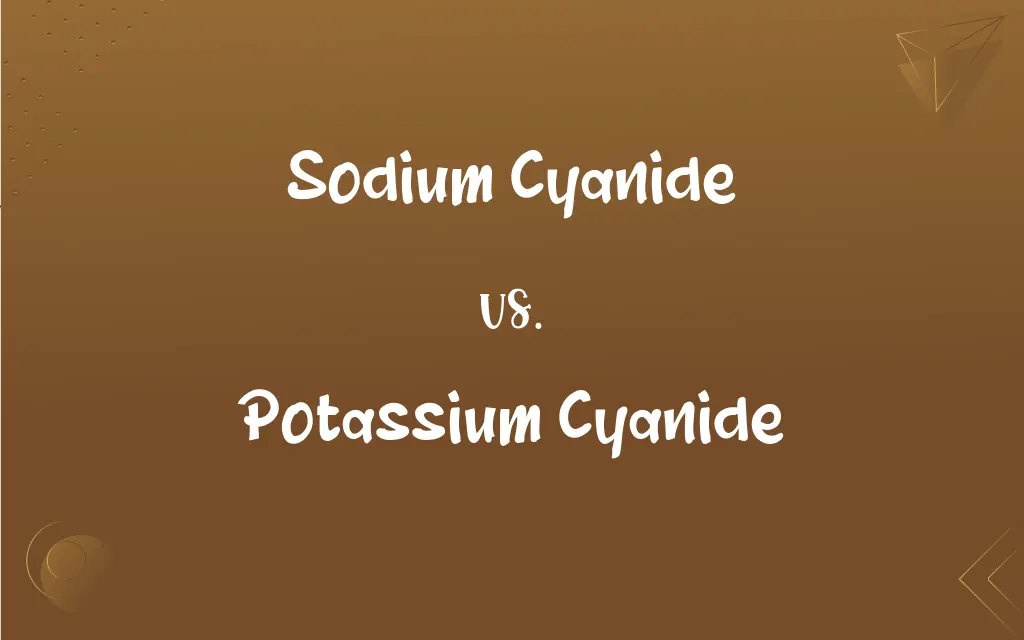Sodium Cyanide vs. Potassium Cyanide: What's the Difference?
Edited by Harlon Moss || By Janet White || Updated on July 10, 2024
Sodium cyanide (NaCN) and potassium cyanide (KCN) are both highly toxic cyanide salts, differing mainly in their cation; NaCN contains sodium, while KCN contains potassium.

Key Differences
Sodium cyanide (NaCN) is a chemical compound composed of sodium (Na) ions and cyanide (CN) anions. It is a white, water-soluble solid commonly used in mining to extract gold and silver. Potassium cyanide (KCN), similarly, consists of potassium (K) ions and cyanide anions. It is also a white, water-soluble compound but has a slightly different application profile, including use in organic synthesis and electroplating.
In terms of their physical properties, both compounds are similar, presenting as white crystalline solids that are highly soluble in water. However, the solubility of potassium cyanide is slightly higher than that of sodium cyanide. This difference can affect their use in various industrial processes.
Sodium cyanide is primarily used in the mining industry for gold and silver extraction, utilizing its ability to form strong complexes with these metals. Potassium cyanide, while also used in metal extraction, finds more application in organic synthesis, where its potassium content can influence reaction outcomes differently than sodium.
Both compounds are extremely toxic, with the toxicity primarily due to the cyanide ion. The human body reacts similarly to both compounds; they inhibit cellular respiration, leading to rapid onset of symptoms and potential fatality. The handling and disposal of both compounds are strictly regulated due to their high toxicity.
Despite their similarities, sodium cyanide and potassium cyanide are chosen for specific applications based on their physical and chemical properties. Their differing sodium and potassium contents can affect both their reactivity and their use in various industrial and chemical processes.
ADVERTISEMENT
Comparison Chart
Chemical Composition
Contains sodium (Na) ions
Contains potassium (K) ions
Solubility in Water
Highly soluble, slightly less than KCN
Slightly more soluble than NaCN
Primary Uses
Used mainly in gold and silver mining
Used in organic synthesis and electroplating
Physical Form
White, crystalline solid
White, crystalline solid, similar to NaCN
Toxicity
Highly toxic, inhibits cellular respiration
Similarly toxic, with rapid onset of symptoms
ADVERTISEMENT
Sodium Cyanide and Potassium Cyanide Definitions
Sodium Cyanide
A white, water-soluble solid.
Sodium cyanide dissolves readily in water for industrial use.
Potassium Cyanide
A potassium salt of hydrocyanic acid.
Potassium cyanide is used in electroplating processes.
Sodium Cyanide
A compound with high toxicity.
Strict safety protocols are followed when handling sodium cyanide.
Potassium Cyanide
Appears as a white crystalline solid.
Potassium cyanide is stored as a dry, white solid.
Sodium Cyanide
Common in gold and silver mining processes.
Sodium cyanide plays a key role in the cyanidation process.
Potassium Cyanide
A highly toxic, water-soluble compound.
Potassium cyanide must be handled with extreme care due to its toxicity.
Sodium Cyanide
Used in chemical reactions for metal extraction.
The mining industry relies on sodium cyanide for metal leaching.
Potassium Cyanide
Potassium variant of cyanide compounds.
Potassium cyanide differs from sodium cyanide in its potassium content.
Sodium Cyanide
A sodium salt of hydrocyanic acid.
Sodium cyanide is utilized in extracting gold from ore.
Potassium Cyanide
Used in organic synthesis and metal extraction.
Organic chemists sometimes use potassium cyanide for synthesis.
FAQs
What is sodium cyanide used for?
Mainly for gold and silver extraction in mining.
Is sodium cyanide water-soluble?
Yes, it dissolves easily in water.
How soluble is potassium cyanide in water?
It's highly soluble, slightly more so than sodium cyanide.
What are the uses of potassium cyanide?
In electroplating, gold extraction, and organic synthesis.
Can sodium cyanide be used in organic synthesis?
It's less common than potassium cyanide for this purpose.
Is potassium cyanide used in mining?
Yes, but less frequently than sodium cyanide.
What precautions are needed for potassium cyanide?
Strict handling, storage, and disposal procedures due to its toxicity.
How does potassium cyanide look?
Similar to sodium cyanide, it's a white crystalline substance.
What happens when potassium cyanide reacts with acids?
It releases highly toxic hydrogen cyanide gas.
What are the dangers of sodium cyanide?
It's extremely toxic and can be fatal if ingested or inhaled.
What is the appearance of sodium cyanide?
A white, crystalline solid.
Can sodium cyanide be used in electroplating?
It's possible, but potassium cyanide is more commonly used.
What safety equipment is needed for handling potassium cyanide?
Protective clothing, gloves, eyewear, and proper ventilation.
How should potassium cyanide be stored?
In a cool, dry, well-ventilated area away from acids.
Is sodium cyanide a stable compound?
Yes, it's stable under normal conditions but releases toxic gas when reacting with acids.
What is the lethal dose of potassium cyanide?
A very small amount, usually less than a gram, can be lethal.
How does sodium cyanide affect the body?
It inhibits cellular respiration, leading to potential fatality.
Can sodium cyanide be neutralized?
Yes, using specific chemical treatments.
Are there environmental concerns with sodium cyanide?
Yes, its use and disposal can impact the environment and wildlife.
Is potassium cyanide regulated?
Yes, its sale, use, and disposal are strictly regulated due to its toxicity.
About Author
Written by
Janet WhiteJanet White has been an esteemed writer and blogger for Difference Wiki. Holding a Master's degree in Science and Medical Journalism from the prestigious Boston University, she has consistently demonstrated her expertise and passion for her field. When she's not immersed in her work, Janet relishes her time exercising, delving into a good book, and cherishing moments with friends and family.
Edited by
Harlon MossHarlon is a seasoned quality moderator and accomplished content writer for Difference Wiki. An alumnus of the prestigious University of California, he earned his degree in Computer Science. Leveraging his academic background, Harlon brings a meticulous and informed perspective to his work, ensuring content accuracy and excellence.






































































